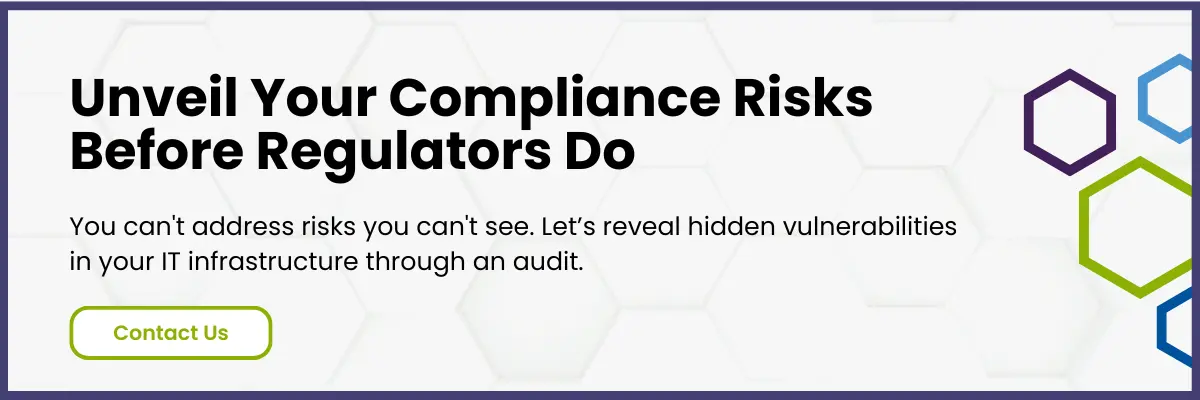Financial services firms face a myriad of compliance risks that can lead to substantial penalties, reputational damage, and operational disruptions. While you’ve likely established compliance frameworks and familiarized yourself with requirements like PCI-DSS and SOX, the sheer number of possible vulnerabilities makes it incredibly challenging not to miss points of exposure within your business.
We’ve identified five commonly overlooked compliance risks that financial services firms should address immediately. Read on to find out where your blind spots are and how best to address them.
1. The Invisible Compliance Risk for Financial services firms
Shadow IT – technology implemented without explicit IT department approval poses – one of the most significant yet overlooked financial services firm compliance risks. When employees use unauthorized cloud services, applications, or devices, they create data governance nightmares that compliance officers may not even know exist.
Why It’s Dangerous:
- Lack of visibility into where sensitive financial information resides
- Can lead to unmonitored data storage and sharing outside your security perimeter
- Potential regulatory violations occurring without management awareness, meaning slower response times and more significant damage
The Solution Strategy
- Implement regular network monitoring to identify unauthorized applications and services.
- Create a simplified application approval process that gives employees legitimate channels to adopt new tools while maintaining compliance.
- Consider implementing a Cloud Access Security Broker (CASB) solution to gain visibility into cloud application usage across your organization.
Top Tip: Foster a culture of compliance by educating employees about the risks of shadow IT. Regular training sessions that explain the “why” behind policies (rather than just the rules themselves) can significantly reduce shadow IT adoption.
2. Outdated Encryption Standards
Too many financial services firms still rely on encryption protocols that have long been proven vulnerable. It’s rarely intentional, but this oversight is one of the most dangerous compliance risks for St. Louis businesses and financial firms nationwide.
Common Encryption Oversights Include:
- Continuing to use SSL instead of TLS for secure communications
- Relying on outdated TLS versions (1.0/1.1) that no longer meet compliance requirements
Failing to implement end-to-end encryption for sensitive communications
You could lose critical information to:
The Solution Strategy
- Conduct a comprehensive encryption audit across all systems, applications, and communications channels.
- Implement regular scanning for weak encryption protocols and establish a process to stay current with evolving encryption standards.
- Document your encryption practices and create a schedule for regular reviews as part of your compliance framework.
Top Tip: Remember that many regulatory frameworks explicitly require strong encryption. Failing to maintain current standards could directly violate GLBA, PCI DSS, and other regulations specific to financial services firms. It’s not optional—so if it’s an area you struggle with, it’s well worth getting guidance from an experienced IT team.
3. Inadequate Vendor Risk Management
Third-party vendors with access to your sensitive data represent a substantial compliance risk that many financial services firms underestimate. Regulatory bodies increasingly hold financial organizations accountable for their vendors’ compliance failures (just look at Morgan Stanley). Your partners’ compliance is your responsibility—one that extends throughout the entire supply chain.
Vendor Red Flags That Cause Financial services firm Compliance Risks:
- Incomplete due diligence processes that fail to evaluate compliance capabilities
- Contracts missing specific compliance and security requirements
- Inadequate ongoing monitoring of vendor compliance activities
The Solution Strategy
- Develop a comprehensive vendor management program that includes thorough pre-engagement due diligence, clear contractual obligations regarding compliance, and regular auditing. Implement a tiered approach based on the level of access vendors have to sensitive data, with the most rigorous controls applied to those handling the most sensitive information.
- Create a vendor inventory that documents compliance requirements, certifications, and audit schedules for each relationship. For high-risk vendors, consider requiring compliance reports, penetration testing results, or other evidence of compliance on a regular basis.
Top Tip: Small financial services firms facing compliance risks should be particularly vigilant about vendor relationships. You may have fewer resources to address vendor-related compliance failures—but you’ll be held to the same standard as larger organizations.
4. Digital Transformation Drift
- In the effort to embrace digital transformation, you might not notice gaps emerging between your existing compliance protocols and new technologies—particularly if you aren’t reviewing these protocols regularly.Yes, it’s an added task, but it’s better you find these gaps than a regulator—or worse, a cybercriminal.
Warning Signs of Protocol Gaps:
- New digital tools implemented without corresponding updates to access control policies
- Outdated policies that don’t address current technologies (mobile banking, APIs, etc.)
- Compliance documentation that employees can’t easily access or understand
The Solution Strategy
- Establish a mandatory compliance review for all new technology initiatives. Create a quarterly schedule for reviewing and updating compliance protocols, with more frequent reviews whenever new systems or processes are implemented.
- Focus on making compliance understandable and accessible to all employees. The most comprehensive compliance framework provides little protection if employees don’t understand (or can’t easily access) the policies. Documentation should be clear, concise, and readily available to those who need it.
5. Untested Disaster Recovery Plans
Disaster recovery isn’t just an operational concern—it’s a compliance requirement for financial services firms. Regulators expect you to maintain business continuity capabilities that protect customer data and ensure access to financial services, even during disruptions.
Common Disaster Recovery Compliance Gaps:
- Recovery plans that exist on paper but haven’t been tested in years (and don’t address current systems or technologies)
- Incomplete testing that fails to simulate realistic scenarios
- Recovery capabilities that don’t meet regulatory timeframe requirements
The Solution Strategy
- Develop a disaster recovery testing schedule that includes full-scale simulations, not just tabletop exercises.
- Document all test results, including identified gaps and remediation plans.
- Update your recovery procedures whenever systems change, and ensure that recovery timeframes align with regulatory requirements.
Top Tip: Consider implementing automated disaster recovery solutions that can significantly reduce recovery times while improving compliance. Modern disaster recovery platforms can provide detailed reporting for compliance documentation while ensuring critical financial systems remain available.
Let’s Address Your IT Compliance Risks
For compliance officers in financial services firms, addressing these frequently overlooked risks requires a proactive approach—and often, some additional support.
Our team can conduct a gap analysis that specifically looks for these blind spots in your current compliance program and then help you implement technical controls, automation, and monitoring solutions that make compliance more manageable.
Anderson Technologies: Real People Creating Business-Changing IT Solutions
For over 30 years, Anderson Technologies has leveraged our expertise for the benefit of our clients, supplying them with suitable, secure IT and strategic guidance for their technological future.
We’re a dynamic team of IT professionals with over 200 years of combined experience and specialist certifications to back up our knowledge. As a trusted advisor, we don’t just focus on today. We strive to take your technology light-years ahead of your competition and scale with your business’s success.
Want to see where data could be at risk in your business? Book an IT security assessment now.



